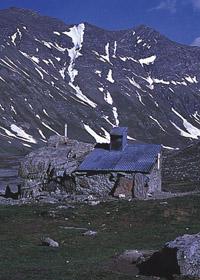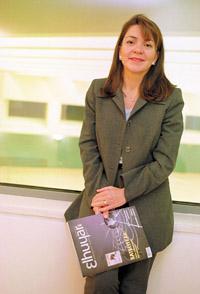Young architect Nicoletta del Bufalo looks for healthy buildings
Now you work in Madrid, right?
Yes. In principle I am project evaluator at the English company ECOTEC. This company has several locations: Birmingham, London, Brussels and Madrid. I am there. For fifteen years I have been related to the area of building savings. I now work for the European Commission on these issues. ECOTEC offers experts in these areas.
What is your concrete obligation?
From any European state we receive projects related to energy and construction and I am one of the evaluators of those projects. These assessments are mandatory since the signing of Kyoto. For example, an agreement was signed not to issue carbon dioxide concentrations above certain limits. Levels much lower than the current spill are required. Therefore, some European projects have had to stop for not meeting the requirements.
His specialty is energy efficiency. What is it based on?
The basis must be operational, both in the construction and use of new technologies. The energy "healthy" building is characterized by the use of design criteria that exploit the advantages of solar energy, the use of orientation and thermal mass (thickness of the walls), the proper arrangement of the windows. Important steps have been taken over the last ten years in the area of professional staff awareness.
And the location of the houses?
It is not yet a topic we include in these projects, but it is very interesting. This problem is evident in poor territories, but at the moment only economic arguments (or almost exclusively) are used to decide their location. Often the floor under the buildings is not suitable to withstand so much weight. It is an obvious consequence of overexploitation. It is built very fast, without proper testing. This has a huge environmental impact that takes many years to return to the initial situation.

How is the research done?
Research and experimentation has been carried out in other buildings and some technologies have been analyzed and developed by other ways. Therefore, research has no place in these projects. There is a large technological offer on the market. Therefore, the advice is to use what is there.
However, the Fifth MARCO Programme (R&D) should be highlighted. This programme, managed by the European Research Office, aims to promote projects that respect energy savings. To do this, it offers financial aid for the progressive incorporation of professionals and staff within this area. Of course, it doesn't give money for projects like always. In this way, the construction of new things would allow, among other things, to reinforce the framework of energy savings. If that were not enough, it would be a great success.
You are driving the use of renewable energy, but are there buildings that become autonomous with these systems?
Yes, there are things that have been used to experience. In southern Italy and Spain there are examples of this, for example in Andalusia. The mountain huts of Germany and other villages are a very beautiful example. Although solar panels are expensive, the connection to the power grid is much more expensive than the use of photovoltaic energy. In some cases it is necessary to use biomass, mainly wood. Thus, shelters can become energetically autonomous. The improvement of conventional technology in urban buildings must be very careful, such as structure, orientation, etc.
In the cabins of the shepherds have also multiplied solar panels, but also gasoline generators are seen
No wonder. Solar energy has produced a very curious effect. In the last two decades it has suffered a remarkable decline. Although technology is not complex, especially in southern Europe, it has sold a lot without providing maintenance services. It was really useful in the short term. People were hopeless. On the contrary, the new generations of these systems have a longer life and, in addition, companies offer a care and a post-sale solution. That's what the user needs. It is related to the advancement of solar panel technology. They are cheaper and more reliable.
Does energy efficiency never produce a decrease in quality?
Theoretically not, but only theoretically. In that direction there is a lot of work. Integration is a key word. This is the set of techniques to improve. The new technology of recent years cannot be used in conventional homes of yesteryear, for example. Experiments have been carried out, for example, in buildings without a fixed user. These buildings are "healthy", that is, they save a lot of energy, they have ideal conditions to allocate resources, etc. The users of these buildings are satisfied.
Traditional wisdom is also reflected in ancient constructions. Is that not lost?
Yes, there is much wisdom in ancient architecture and it has been lost. For example, street and house refreshment systems in hot villages have been received from the Arabs. Only one adaptation was made. For example, the holes to drive the air are then. They were also used by the Romans, but at least it is a technology of 2,500 years ago. The current work is to reread and learn to use all that knowledge. Another is the wisdom of cold peoples. Unfortunately, much has been lost. Here there was a remarkable advance between the sixties and eighties; in Italy, for example, the Second World War occurred between the forties and eighties. This advance has great importance as many houses have been built. However, the quality of these buildings is much lower. Now in Europe there is not much tendency to build, but to renew the existing. Therefore, it may be a good time to recover traditional architecture techniques.

What are the countries that spend the most money on these issues?
All countries spend, but we must recognize that the greatest endowment is from the countries of the north, especially Denmark. In Denmark this type of building is common. For example, District Heating System is an invention of 1920. Helsinki is also about twelve years later. There are many differences. But gradually most states have begun to put money into it. It must be said that in the schools of architecture of other peoples, in the school in which I studied, for example, there are no subjects on this subject. Courses in environmental architecture, bioclimatic or energy demonstration technologies have recently been launched in schools. This means that teachers do not know these topics either. Therefore, whoever decides how the buildings will be built and how the money will be distributed is sometimes not well aware. On the contrary, in the northern villages it is something old.
However, the impact of climatology on these peoples is evident and pushes them to it, right?
Yes, of course. But keep in mind that southern countries are also masters in passive cooling. What we mentioned above is how to cool rooms without using electricity. This is also an issue driven by the need for the South. Also England has a great experience, but not similar to Denmark or Sweden. France is the first in climate research, but conceptual and non-practical. The Germans are the best in photovoltaic energy and the Spaniards in wind energy, although less oriented to buildings.
Buletina
Bidali zure helbide elektronikoa eta jaso asteroko buletina zure sarrera-ontzian











